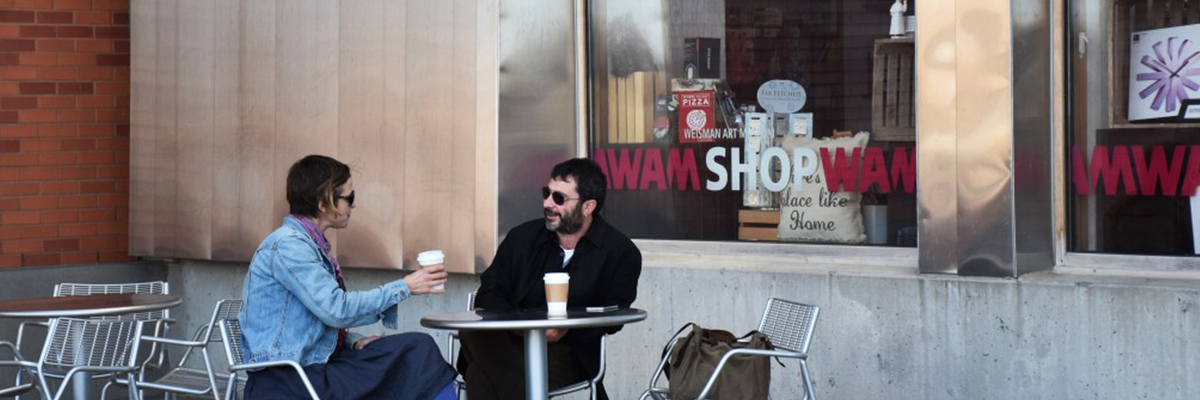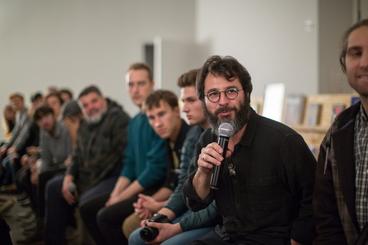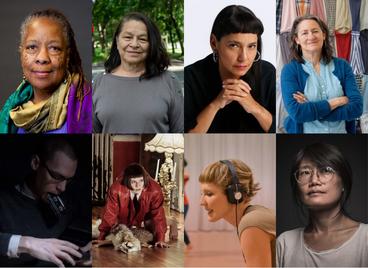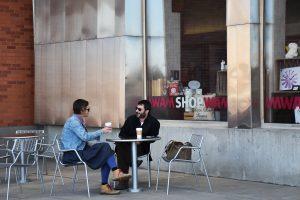
FEATURED ESSAY
Collaboration Is a Labor of Creating Shared Meaning
I have an unusual job title: Curator for Creative Collaboration. This is not a position found in most art museums, and you might wonder why our museum has such a role.
The first reason for my job has to do with the historic function of art museums, which is to preserve and display art. When museums preserve and display a certain art form, they support artists who work in that form. For example, over the centuries, museums have developed a sophisticated system for collecting and displaying paintings. Museums know how to accession paintings into collections; how to transport, store, and display them; how to communicate about them to the public, and so on. Paintings in museums, in turn, support an ecosystem of collectors, galleries, auction houses, and others who are skilled in dealing with paintings. When artists work on a painting, they do so knowing there is a system of support out there that understands what to do once their artwork is ready to leave the studio.
Throughout history, artists have been constantly creating new art forms. In this process, artists are always ahead of museums. Museums had to (and forever will have to) catch up and learn how to work with the new things artists come up with. Museums don’t always do a good job at this; it can take a very long time for them to catch up. But that has never stopped artists from innovating; the slower pace of institutions just challenges their lives and careers more in the interim. The consequence for art museums is that there are and always will be new art forms that they don’t yet know how to preserve, display, and support. These innovations in form are part of artists’ practice, and museums have a duty to learn how to support them just as well as they do more established art forms, like painting.
The second reason for my position is more specific to the vital importance of collaboration in the arts today—specifically, collaboration between artists and professionals in other fields. One central development in contemporary art is a host of practices collected under the umbrella term “socially engaged arts,” which loosely refers to practices in which artists address issues of social concern by working directly with those issues (as opposed to making art about them). Many of those concerns traditionally belong to fields outside the arts, such as governance, business, politics, or topical research in the humanities or sciences. Artist and educator Pablo Helguera described this process in his book Education for Socially Engaged Art:
Socially engaged art functions by attaching itself to subjects and problems that normally belong to other disciplines, moving them temporarily into a space of ambiguity. It is this temporary snatching away of subjects into the realm of art-making that brings new insights to a particular problem or condition and in turn makes it visible to other disciplines.
The act of attaching to subjects and problems that normally belong to other disciplines amounts to collaborating with practitioners working in those disciplines—many of whom work at universities. The intuition behind WAM’s program for creative collaboration, and behind my job at the museum, is that we will be much more effective at addressing problems in the world if artists and researchers who work on similar problems could combine their creative powers. This is a wonderful intention that makes perfect sense. But there’s a complication.
Artists study in art schools, work in studios and neighborhoods, and exhibit their art in galleries, festivals, and museums. Researchers study in schools of sciences, engineering, and humanities, work in laboratories and offices on campuses, and present in discipline-specific conferences and journals. Artists and researchers have different daily routines and social circles; they operate within different cultures, communities, structures of labor and financial reward; they use disparate professional lexicons and are driven by differing motivations. The result is what we call a “sector divide,” which is very different from “disciplinary divide.”
The distinction between discipline and sector is important, because the task of cross-sector collaboration is different from that of a cross-disciplinary engagement. Our social and institutional structures ensure that sectors don’t mix. Most artists and researchers rarely have opportunities in their professional and personal lives to meet and converse with each other. And even if and when these discussions do happen, mere acquaintance is not enough: collaborations do not develop from single encounters. Those initial conversations might trigger curiosity and intuition that something more is possible, but developing early intuitions into fully formed ideas, and then into fundable projects, requires much more than a single interaction.
Initiating and establishing a working relationship involves sustained effort over a significant period of time, and here is where the wonderful intention of creative collaboration becomes exceedingly complex to implement, and where it is important to appreciate the difference between disciplinary and sector divides. Next to nothing in either sector (the arts or academia) motivates and supports artists and researchers in sustained conversations for periods of time long enough to develop their shared intuitions into viable projects. The opposite is true: many factors in both sectors actively inhibit such extended interactions.
Few people would disagree that collaborations are desirable. Our challenge is that we, as a museum, a university, and a society, do not have the mechanisms for adequate support of sustained collaborations across sectors.
We learn by asking questions about the world. Those questions are ultimately determined by our value systems, histories, politics, conventions, identities, and beliefs—in short, by our cultures. As with many things we deal with in the university, creative collaboration is about learning and innovation. But this is innovation of a very special kind, what we might call cultural innovation. It is similar to scientific innovation in that it is about expanding our knowledge and our ability to address issues in the world. It is also very different in that cultural innovation is about achieving this expansion by reimagining the very way we ask questions about the world.
At the end of the 1960s, artist and theorist Jack Burnham declared the rise of Systems Esthetics and with it a new function of art that “does not reside in material entities, but in relations between people and between people and the components of their environment.” Those relationships are products of our cultures and, over the better part of contemporary art history, artists have been developing the skill of interrogating the social constructs that determine relationships. The focus on culture, and on artists as carriers, researchers and mediators of cultures, is essential to our ability to deal with the challenges we face.
How does this cultural innovation feel, in practice? I am reminded of a meeting I sat in last year. As in many other meetings I attend at the university and the museum, we talked about diversity. We also talked about metaphors and how they can help us understand diversity. The subject of this meeting, however, had little to do with art museum audiences or programs; instead, we talked about adolescent psychiatry. The meeting was part of the “Art and Health” program of WAM and the University of Minnesota Medical School: a collaboration between poet Yuko Taniguchi, social practice artist Peng Wu, psychiatrist Kathryn Cullen, and neurologist Michael Howell. In that meeting, we discussed “circadian rhythm diversity,” a term the collaborators devised to describe the variability in individual circadian rhythms that causes people to have different sleep patterns from each other.
Circadian rhythm is a biological process that regulates sleep cycles of organisms. Diversity, as most of us use the term today, is a catch-all word for multitudes of cultures, peoples, and abilities, most commonly used in the context of our disastrous inability to contain all that richness of human experience. The expression circadian rhythm diversity hijacks a biological term from the boundaries of a discipline and places it in the broad context of culture—with very tangible practical consequences. Use the word “diversity” and, all of a sudden, the conversation shifts from treatment of insomnia to inclusivity, and then to a question that integrates concerns from both: How can we, as a culture and as a healthcare system, embrace all the richness of naturally variable sleep patterns, as opposed to attempting to normalize them with treatments and medications?
In that same meeting, our conversation meandered to another cultural concept, this time concerning language. We talked about the metaphors that participants in Yuko’s poetry workshops used when describing their sleep habits and what those expressions reveal about the practical consequences of their different circadian rhythms. We also discussed the implications those revelations might have for medical practitioners and their clinical work. It was a wide-ranging conversation about culture, art, and medicine that all participants, artists and medical researchers, found deeply meaningful to their work.
That experience puts me in mind of the opening statement of Metaphors We Live By, the classic book by linguists George Lakoff and Mark Johnson, in which they write about the intuition that motivated their work, that:
…the dominant views on meaning in Western philosophy and linguistics are inadequate—that “meaning” in these traditions has very little to do with what people find meaningful in their lives.
Lakoff and Johnson treat metaphors not as figures of speech or poetic expressions but as working paradigms that actively shape how we behave and make decisions. This treatment makes metaphors very important in understanding the complexity of creative collaboration. In every discipline, we use different metaphors, tools, and languages to create meaning. Most of the time, these will be very different from what people outside our respective fields find meaningful.
The work of collaboration is the hard labor of creating shared meaning.
Metaphors that structure my work change with experience. When I joined the museum in 2017, I started thinking about the Target Studio for Creative Collaboration as a platform to empower artists in developing ambitious collaborative initiatives. As time has passed, I have become dissatisfied with this metaphor because it assumes a curatorial position of power with respect to the artists, which feels inadequate to the goal of cultivating new cultures of relationships: if we see artists as disruptors and innovators of cultures, we cannot think of them as being in need of support. Rather, we must see them as leaders and collaborators.
I later adopted another metaphor, picked up from the British curator Hans Ulrich Obrist, that of a junction:
…the task of curating is to make junctions, to allow different elements to touch. You might describe it as an attempted pollination of culture, or a form of map-making that opens new routes through the city, a people or a world.
But then junction too became unsatisfying, because it does not account for the need for sustained interactions that lead to viable collaborations. We need junctions, because we need the cultures to touch and conversations to start, but we must also have a system in place that maintains continued, open-ended conversation for as long as it takes to develop shared ideas into impactful actions. Junctions alone don’t do that.
I learned my latest metaphor from the writer and curator Regine Basha, in a recent collection of interviews with a wonderful title, As Radical, As Mother, As Salad, As Shelter: What Should Art Institutions Do Now?: “One of the artist’s roles is to upend the status quo, and one of the curator’s roles is to weave the connective tissue around that process.”
During the past decades, artists became infinitely more adept at the work of upending cultural status quos, while art institutions have increasingly lagged far behind in their ability to support that work. As I understand it now, facilitating the labor of creating shared meaning entails weaving the connective tissue that supports artists’ work. And that is the job of the Curator for Creative Collaboration—as I see it at this moment in time.


